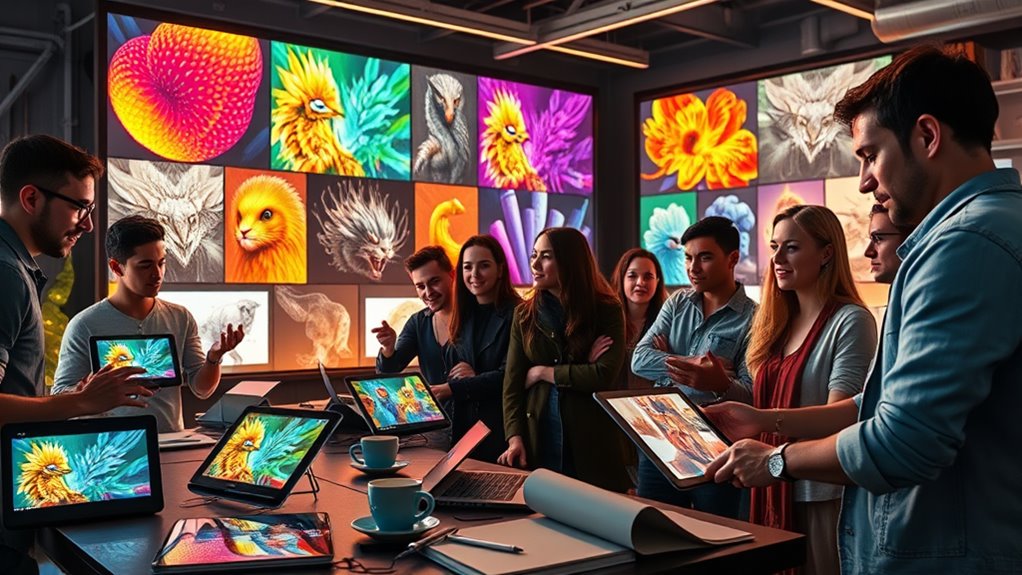
When you're evaluating NFT marketplaces, considering selection and usability, fees and community engagement, and exclusivity and accessibility is essential. Each platform offers distinct advantages that can align with your specific needs, yet the differences can be subtle and impactful. Understanding these nuances could greatly influence your buying or selling experience, but which marketplace truly meets your expectations? As you navigate through the options, the key factors might just surprise you.
Overview of Key Marketplaces
When diving into the world of NFTs, understanding the key marketplaces is essential for making informed decisions. Each platform offers unique user experiences and marketplace features that cater to different preferences and needs.
OpenSea stands out with its support for multiple blockchains, including Ethereum and Solana. It's known for an easy-to-use interface and a vast selection of NFTs, charging a 2.5% transaction fee. This makes it a popular choice for both beginners and seasoned collectors. Additionally, it has gained traction with the rise of the Metaverse, which has further expanded its user base.
Rarible focuses on empowering creators, allowing them to create, sell, and collect digital items. With a strong emphasis on community-driven features and live online training, it enhances user experiences, particularly for those interested in art and collectibles.
Binance NFT offers a simple interface, especially for users familiar with the Binance ecosystem. It supports over 1,500 cryptocurrencies as payment methods and has low minting fees, making it accessible for many.
Finally, Nifty Gateway specializes in high-quality, limited-edition digital art NFTs. It uses "drops" to showcase creations from renowned artists, emphasizing quality over quantity.
Each marketplace has its strengths, so understanding these features can help you choose wisely.
Types of NFT Marketplaces
NFT marketplaces can be categorized into four main types: open, curated, niche-specific, and gaming/virtual world platforms.
Each type offers unique features that can enhance your experience while ensuring safety.
Open marketplaces, like OpenSea and Rarible, support a wide variety of NFTs, making them accessible for anyone to mint, buy, or sell.
Their flexibility attracts diverse users but requires you to be cautious about quality and authenticity.
Curated platforms, such as SuperRare and Nifty Gateway, focus on high-quality NFTs.
They've strict selection criteria, requiring creators to undergo an approval process, which adds a layer of safety for collectors looking for unique items.
Niche-specific marketplaces cater to particular industries or interests, such as art or gaming.
These platforms, like Rarible and Decentraland, provide tailored experiences, enhancing your engagement with specific types of NFTs.
Finally, gaming/virtual world platforms specialize in game assets and virtual environments, creating immersive experiences for users.
Blockchain Support for NFTs
Understanding the types of NFT marketplaces is just the beginning; the underlying blockchain technology plays a vital role in how NFTs function and are traded. Each blockchain has unique advantages that affect NFT scalability and security.
Ethereum is the pioneer in the NFT space, offering strong smart contract capabilities and a vast ecosystem. However, it can have high transaction fees and slower speeds. High gas fees on Ethereum can be a significant downside for many users.
Polygon enhances Ethereum's scalability and offers lower transaction costs, but it's not as decentralized.
Solana stands out for its high transaction speed and low fees, making it ideal for high-volume NFT trading.
Flow is optimized for NFTs and has a user-friendly interface, particularly appealing to creators in gaming and art. However, its compatibility with other blockchains is limited.
Bitcoin, while not native to NFTs, provides strong security through additional layers, ensuring stability.
Each blockchain presents its own set of advantages and challenges, so when choosing a marketplace, consider these factors carefully.
Understanding Fee Structures
Steering through the fee structures of various NFT marketplaces can feel overwhelming, but it's vital for maximizing your trading experience. Understanding the nuances of these fees will help you make informed choices while ensuring transaction transparency.
Start with a fee comparison across platforms. For instance, OpenSea charges a 2.5% transaction fee on secondary sales, while X2Y2 offers a lower fee of just 0.5%. On the other hand, platforms like SuperRare can charge up to 15% on sales, so knowing these figures is important. Additionally, considering gas fees can significantly impact your overall costs, especially on Ethereum-based platforms.
Don't forget about gas fees, which can vary greatly based on the blockchain you choose. Some platforms, like OpenSea and Rarible, provide options for gasless or lazy minting, allowing you to avoid upfront costs.
Additionally, be aware of other potential costs like minting and listing fees. While some platforms charge fees to create an account or list NFTs, others, such as Mintable, offer gasless minting options.
Current Market Trends
The current landscape of digital assets reveals a dynamic and rapidly evolving market, with the global NFT market size reaching an impressive USD 26.9 billion in 2023. This growth is projected to continue, with an expected CAGR of 34.5% from 2024 to 2030.
As you investigate NFT buyer demographics, you'll find that a significant portion of buyers are males aged 35 to 54, primarily drawn to crypto art. However, it's essential to be aware of NFT market volatility. The number of unique NFT buyers surged by 450% between 2020 and 2021 but saw a decline in Q1 2023.
Curiously, major NFT marketplaces like OpenSea and LooksRare dominate trading volume, indicating a concentration of activity among top buyers and sellers. The art segment remains a dominant force in the NFT market, driving much of the interest and investment.
Despite fluctuations, the interest in NFTs remains strong, particularly among e-sports fans and populations in countries like the U.S., U.K., and South Korea. As you consider entering this market, understanding these trends and demographics can aid in making informed decisions while traversing the inherent risks associated with digital assets.
